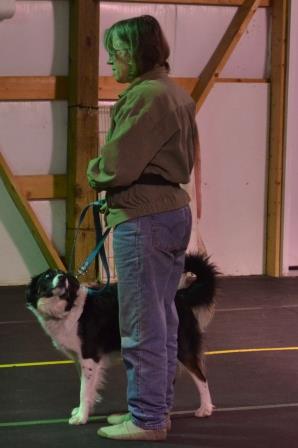
Home > Dispatches > Daily Dispatches 2014 > Daily Dispatch #59
February 28, 2014: Dog Training: Border Collie Cognition
This morning now seems like a long time ago. I took Pete to town early this morning. He got a ride from there to Anchorage where he will first fly to McGrath, then to Rohn, AK. He’s going to be an Iditarod checkpoint volunteer. On the way home, I stopped at the food store and purchased a dog tug toy. Dumb idea. I got home and suddenly foresaw that I could make one using the rope we make our reins out of, and an old Kong toy. Ryder saw the hand-made toy and immediately wanted to play with it. So, this is what we will use in tomorrow’s SAR practice. Today I rode Tinni and took Rainbow, Ryder, and Jenna with me. Aside from both Rainbow and Ryder taking off after a distant car (we were by then on the trail), our outing went well. I next rode Signy, ponied Raudi, and took Hrimmi along. Aside from Signy’s taking off, and me losing Raudi’s line, our outing went |
|
| well. It was quite an endeavor, getting all the animals out in two trips, but I did it. I ought to have known that I could do this; after all, they all get out every day. And although I varied the animals I took out, I didn’t vary the routine. The sun (again) shone brightly, and the air (again) was warm. So, rather than think about how cold I was (which has often been the case), I instead thought about other things, one of which was about Border collie cognition. This is what I know – Stanley Cohen, the author of Dog Intelligence has noted that there are three types of dog intelligence: these are instinctive, adaptive, and working obedience. He further surmised that Border collies are the smartest breed of all because they’ve been used for centuries as working dogs, have high motivation levels, and have had to pay close attention to their owners’ command when engaged in herding activities. Additionally, research studies have found a gene that might be responsible for this higher than average level of intelligence. It’s called CTNND2, and is a genome. This is not hearsay; rather, it’s based on work supported by National Science Foundation grant 0917517. Like I said in previous dispatches, I don’t know if other breeds have cognitive quirks. And I don’t know if other Border collies have cognitive quirks. So I can’t say whether or not Ryder is the exception to the rule. But last weekend I (again) saw an odd behavior that I attribute to the breed. I call it lockdown, and define it as an instance in which the dog becomes near catatonic and ceases to be interested in what the people around her are attempting to get it to do. I saw this with Ryder early on in herding – she at a given point in time would either start eating sheep poop or lay down and appear uninterested in the goings on about her. Last week lockdown occurred during a search and rescue practice session. She spotted the subject, but she was reluctant to interact. She then refused to play with the tug toy. I deal, by putting her back in the truck with Jenna and Rainbow. A half hour later I took her out, and Ryder then rebounded by engaging in a very vigorous tug session. Go figure. I have friends on the east coast who have Border collies. They had three when I visited them. They put their dogs in a windowless mud room when they appeared over stimulated. So maybe there’s something to my observation. The only way to find out for sure is to talk to Border collie owners, handlers, and breeders. In the meantime, I’m going to watch and see if this happens again. I suspect that it won’t. If it does, I’ll be attuned to the primary indicator – a declining interest in finding the subject and in toy drive. I’m keeping a dog log and chronicle what’s going on. And I’m also continuing to write dispatches. I hope the good weather continues to hold. However, I’m concerned about the dogs who will be out on the trail The one’s with shorter coats will best be able to handle the sun’s heat. |
|
